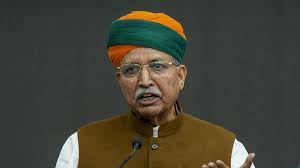Parliament has constitutional right to remove judges, says Law Minister amid impeachment buzz over Justice Varma

New Delhi, July 18, 2025 – Law Minister Arjun Ram Meghwal has asserted that only Parliament has the constitutional right to remove judges. His statement comes amid growing political interest in impeaching Justice Yashwant Varma of the Allahabad High Court.
The Law Minister made it clear that the government will not interfere. He stressed that judicial accountability lies entirely with Parliament, as per the Indian Constitution.
What Sparked the Controversy?
The debate started after a fire broke out at Justice Varma’s Delhi residence in March 2025. While initially thought to be an accident, authorities found half-burnt bundles of ₹500 notes inside the premises.
This discovery raised serious concerns. A Supreme Court panel, led by Chief Justice Sanjiv Khanna, reviewed the matter. The panel concluded that Justice Varma’s conduct amounted to judicial misconduct. Although the panel’s finding isn’t legally binding, it added pressure for formal action.
Parliament’s Constitutional Role
Speaking to the media, Meghwal said:
“The Constitution empowers Parliament to act. Neither the judiciary nor the government can remove a judge.”
Parliamentary Affairs Minister Kiren Rijiju echoed this view. He said, “This is not about politics. Parliament alone holds this responsibility.”
Impeachment Process: What Happens Next?
The Congress party has started collecting signatures to push an impeachment motion. Reports suggest that some opposition MPs are backing the move.
However, several leaders demand access to the Supreme Court panel’s full report. They want to review the findings before signing the motion.
The impeachment process, guided by the Judges (Inquiry) Act, 1968, involves these steps:
- A motion signed by MPs (at least 100 from Lok Sabha or 50 from Rajya Sabha).
- Initial screening by the Speaker or Chairperson.
- Formation of an inquiry committee with a Supreme Court judge, a Chief Justice from a High Court, and a legal expert.
- Investigation and report submission.
- Voting in both Houses with a two-thirds majority.
- Removal order signed by the President if Parliament approves the motion.
Why This Case Is Unique
Judicial impeachment is rare in India. The last attempt in 2011—against Justice Soumitra Sen—ended when he resigned before the Lok Sabha voted.
Justice Varma’s case is different. It involves both a judiciary-initiated probe and strong political interest. Experts say this could become a landmark example of institutional accountability.
The case also raises concerns about in-house judicial panels. Critics argue that such panels don’t give judges a fair chance to defend themselves. The process lacks transparency and denies cross-examination rights.
Justice Varma Defends Himself
Justice Varma has filed a petition in the Supreme Court. He claims the in-house inquiry was biased. His lawyers argue he was not given a fair opportunity to respond.
He maintains his innocence and wants the court to strike down the panel’s findings.
Mixed Reactions from Legal Experts
Many in the legal community are treading carefully. Some advocate for action. Others caution against rushing to judgment without proper investigation.
The Bar Council of India has not taken a clear position. However, some retired judges and legal scholars stress the need for due process.
What This Means for the Judiciary
The outcome of this case could reshape how India handles judicial misconduct. If Parliament moves forward, the process will test the balance between judicial independence and institutional accountability.
It will also raise questions about how in-house inquiries influence political decisions. Many believe India needs a clearer, more transparent system for investigating judges.
Conclusion
The Law Minister’s comments reaffirm Parliament’s exclusive power to remove judges. As the impeachment buzz grows louder, all eyes are on the upcoming Monsoon Session, starting July 21.
Whether the motion moves forward or not, the case of Justice Varma will be remembered as a test of India’s democratic framework.






